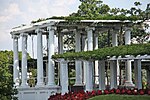John F. Kennedy Eternal Flame
1963 establishments in VirginiaArlington National CemeteryEternal flamesHarv and Sfn no-target errorsJacqueline Kennedy Onassis ... and 3 more
Monuments and memorials in VirginiaMonuments and memorials to John F. Kennedy in the United StatesTombs of presidents of the United States

The John F. Kennedy Eternal Flame is a presidential memorial at the gravesite of assassinated United States President John F. Kennedy, in Arlington National Cemetery in Virginia. This permanent site replaced a temporary grave and eternal flame used at the time of Kennedy's state funeral on November 25, 1963, three days after his assassination. The site was designed by architect John Carl Warnecke, a long-time friend of Kennedy. The permanent John F. Kennedy Eternal Flame grave site was consecrated and opened to the public on March 15, 1967.
Excerpt from the Wikipedia article John F. Kennedy Eternal Flame (License: CC BY-SA 3.0, Authors, Images).John F. Kennedy Eternal Flame
Sheridan Drive, Arlington
Geographical coordinates (GPS) Address External links Nearby Places Show on map
Geographical coordinates (GPS)
| Latitude | Longitude |
|---|---|
| N 38.88153 ° | E -77.0715 ° |
Address
John F. Kennedy Eternal Flame
Sheridan Drive
22211 Arlington
Virginia, United States
Open on Google Maps










